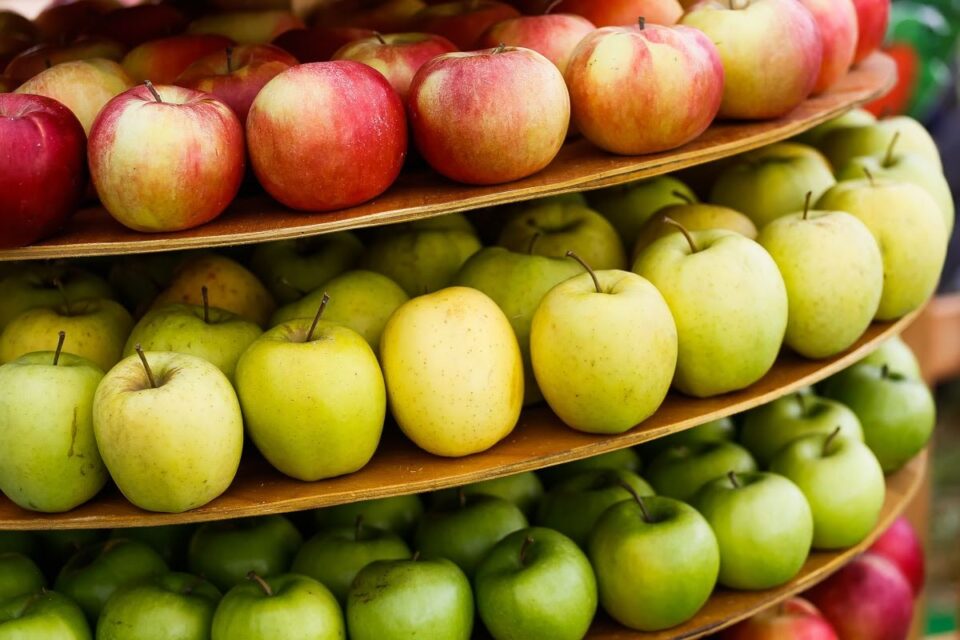This report, prepared by AgroExpert.md, provides an overview of the apple sector in Moldova for the MY 2023/24. It covers the aspects of production, export, processing, and consumption of apples in the country.
Production. According to the Prognosfruit conference, organized by the World Apple and Pear Association (WAPA) in August 2023, the apple production in Moldova was expected at 548 thousand tons.
However, due to the severe drought that lasted until late summer, some Moldovan experts revised the estimate to 480-500 thousand tons. The harvesting campaign in October was generally successful, thanks to the warm and dry weather conditions. A large proportion of small-sized apples and less popular varieties in the European and Middle Eastern markets were directed to the apple juice concentrate factories, but many market players observed that “there was an abundance of apples in the country this year”.
Despite the positive feedback from the field, the Moldova Fruct association lowered its summer forecast of the 2023 harvest to 505 thousand tons in November. The apple harvest in Moldova in the previous years was as follows: 446 thousand tons in 2022, 650 thousand tons in 2021, 430 thousand tons in 2020, 610 thousand tons in 2019, and 665 thousand tons in 2018 (the highest figure in the last decade).
The reason for the downward adjustment of the 2023 forecast by the Moldova Fruct experts was probably the low amount of apples stored in cold chambers for winter-spring sales – about 200 thousand tons, according to expert estimates.
Export. Moldova Fruct projected that the country would export about 185 thousand tons of apples in MY 2023/24 (July-June), which is 60 thousand tons more than in MY 2022/23 (125.2 thousand tons). However, the export performance of Moldovan apples has been lagging behind the previous year’s pace. From July to October of this year, Moldova exported only 23 thousand tons of apples. Therefore, some experts anticipate that the peak period of export sales of Moldovan apples will shift to February-May, as it was before the pandemic.
The apple exports from Moldova in the past years were: 297 thousand tons in MY 2018/19, 237.3 thousand tons in MY 2019/20, 158.4 thousand tons in MY 2020/21, 257.9 thousand tons in MY 2021/22, and 125.2 thousand tons in MY 2022/23.
Read also: Russia failed to hurt Moldova’s apple industry with trade embargo – prices are growing
Processing. The Moldova Fruct association estimated that 250 thousand tons of apples would be processed in the current season at the beginning of MY 2023/24. By the end of November, when the summer-autumn stage of the processing campaign was almost over, the experts of the association confirmed that their estimate matched the actual data.
The representatives of the Association of Fruit and Vegetable Processors Speranța-Con have not yet released the preliminary production figures at the time of writing this report. Some managers of canning enterprises speculated that, considering the full capacity of the factories throughout the autumn, the processing volume of the 2023 apple crop could be much higher than the initial estimate – up to 300 thousand tons.
The domestic market for fresh apples. According to fruit industry experts, Moldova’s annual domestic consumption of fresh apples has been around 50 thousand tons for many years. However, the Moldova Fruct association projected that the domestic market for fresh apples in Moldova would reach 60 thousand tons this marketing year.
This projection seems unrealistic for several reasons.
First, the country’s declining population should be considered. This year, it is unlikely that Moldova will see a significant increase in consumers, whether they are from the diaspora or refugees from Ukraine.
Second, the country’s population has not become more affluent. On the contrary, retailers report that economic hardships have an immediate negative impact on sales, especially of staple food products that are consumed frequently. And the apple is arguably the most “social fruit”.
Third, the apple is not a product that has a strong seasonality – meaning that even in the summer, when there are many alternative products in the fruit range, there will always be a large group of fans of summer apple varieties. Therefore, in the “velvet season of vacations of the Moldovan diaspora”, retailers in the domestic market can sell expensive products, such as berries, peaches, sweet corn, asparagus, but not apples. Hence, there is no reason to expect large sales surges that can influence the overall performance of the apple trade in the domestic fruit market.
Fourth, sales of “social fruits” can increase in years with a high yield and a low price. People who live modestly tend to stock up on food when they have the chance. But in 2023, the prices of apples were hardly low. For this reason, too, MY 2023/24, unfortunately, cannot be seen as a season with favorable conditions for high sales of apples in the domestic market for fresh produce.
The use of the site materials is free if there is a direct and open for search engines hyperlink to a specific publication of the East-Fruit.com website.




